The American Bulldog is a confident dog originally bred for farm work and guarding livestock. These muscular dogs have white coats, often with black, brown, red, tan or brindled patches.
Standard American Bulldog Colors
Let’s have a closer look at the different American Bulldog colors and patterns:
White American Bulldog
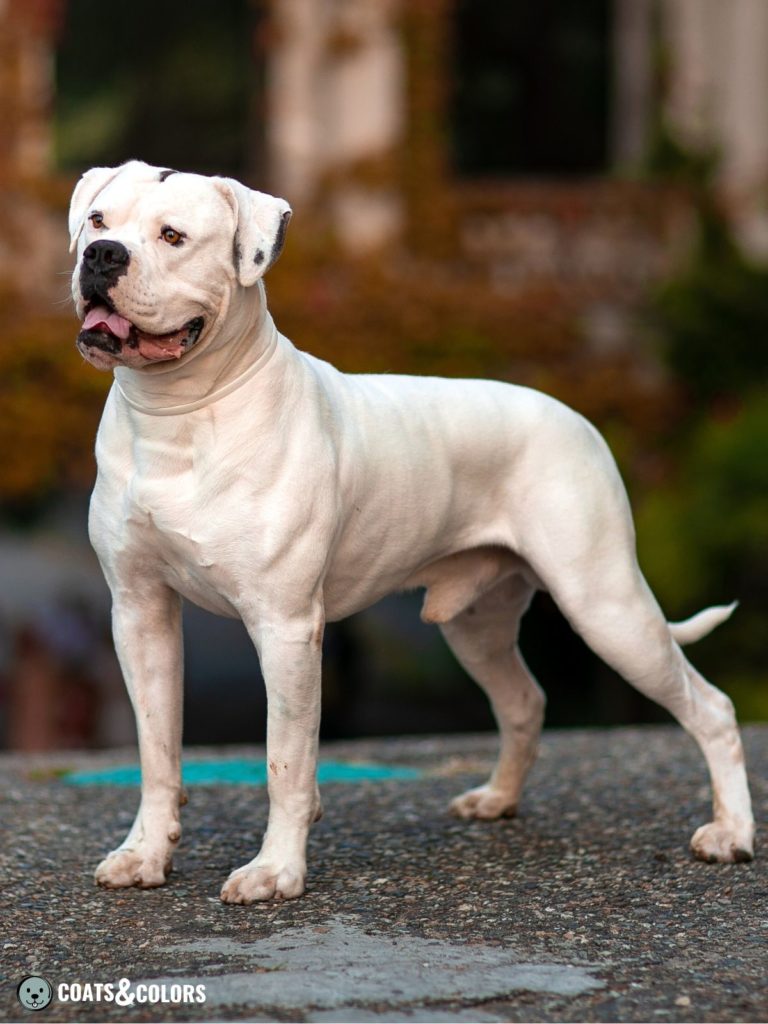
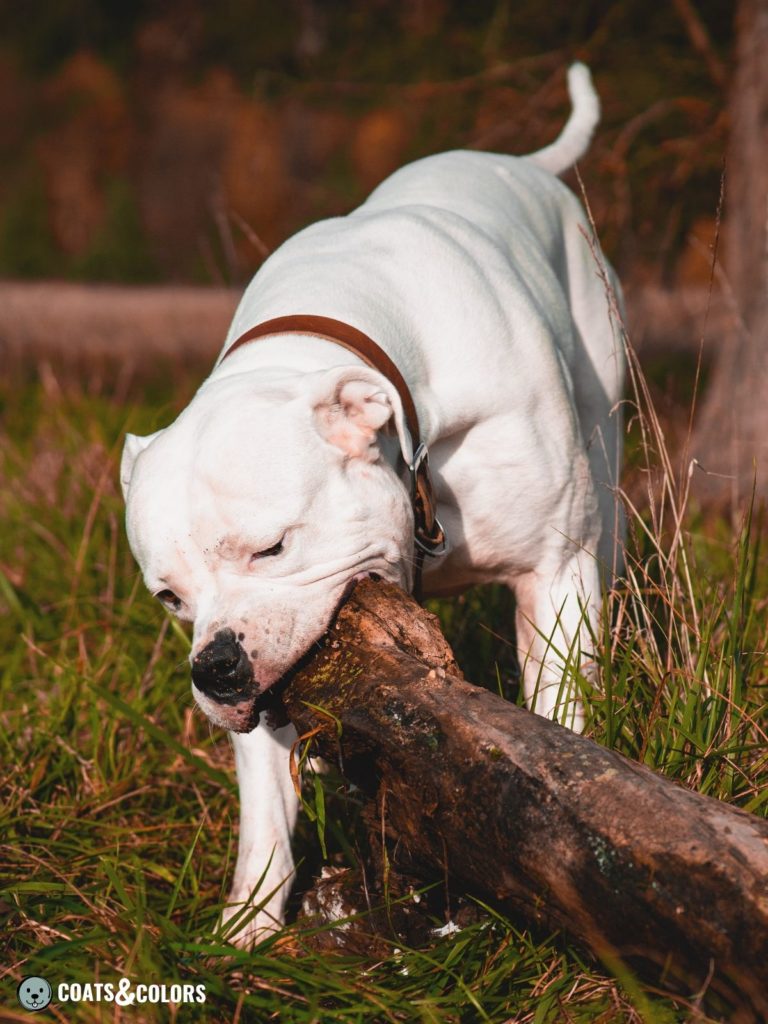



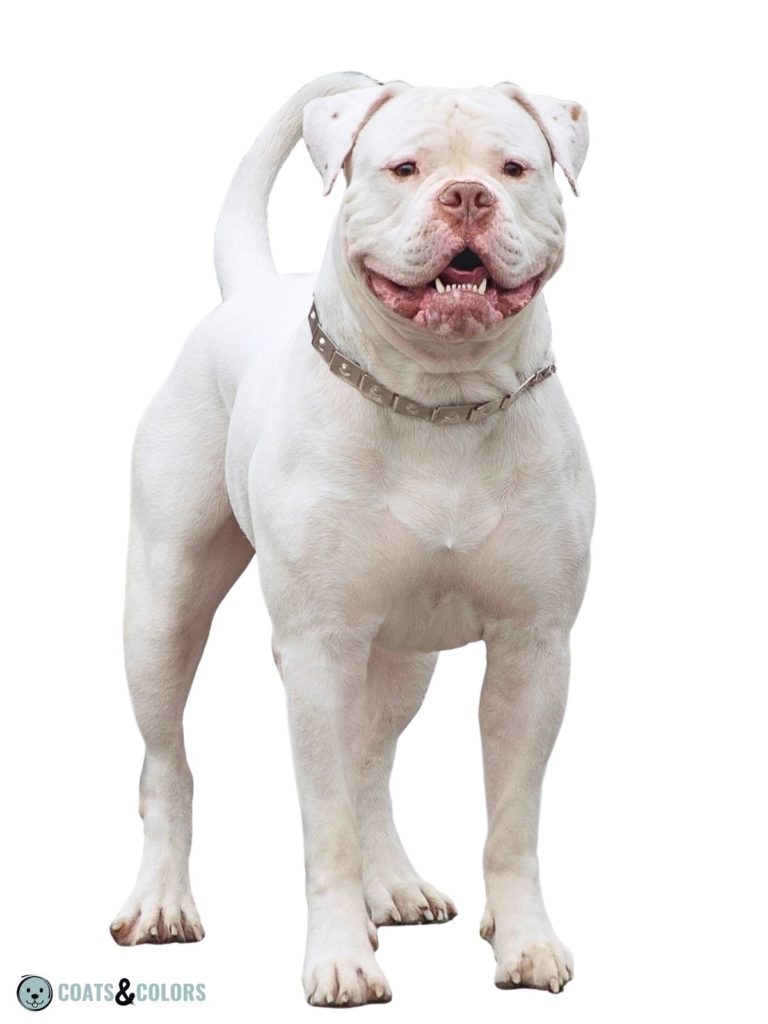
All the colors of American Bulldogs have at least some amount of white. And many specimens have a solid all-white coat which is especially common in this breed.
Pure white American Bulldogs get their color mainly from extreme white spotting. Another trait that adds lots of white to the coat of American Bulldogs is whitehead, which is very common in this breed.
The piebald allele (sP) causes white spotting, in some homozygous dogs (sP/sP) this can cover all of the dog. Whitehead is untestable and adds white mainly to the front of the dog. But in some dogs, it also deletes much of the pigment that would otherwise be found on the rest of the body.
In extreme cases, both traits can cause lots of white on their own. And they can add up if a dog has both. In any case, American Bulldog white is caused by a true lack of pigment in the coat.
An American Bulldog with all white coat still has one of the color patterns typical for the breed such as a brindle or sable. It is just that his pattern is not expressed because he lacks functional pigment cells.
The nose pigment gives away what pigment color the dog has. Most white American Bulldogs have a black nose and brown eyes, but some may have a liver-colored nose and lighter eyes.
Some solid white American Bulldogs show varying amounts of ticking in their coat. Or they look blotched from small dots of dark skin pigment shining through the white coat.
White & Black American Bulldog
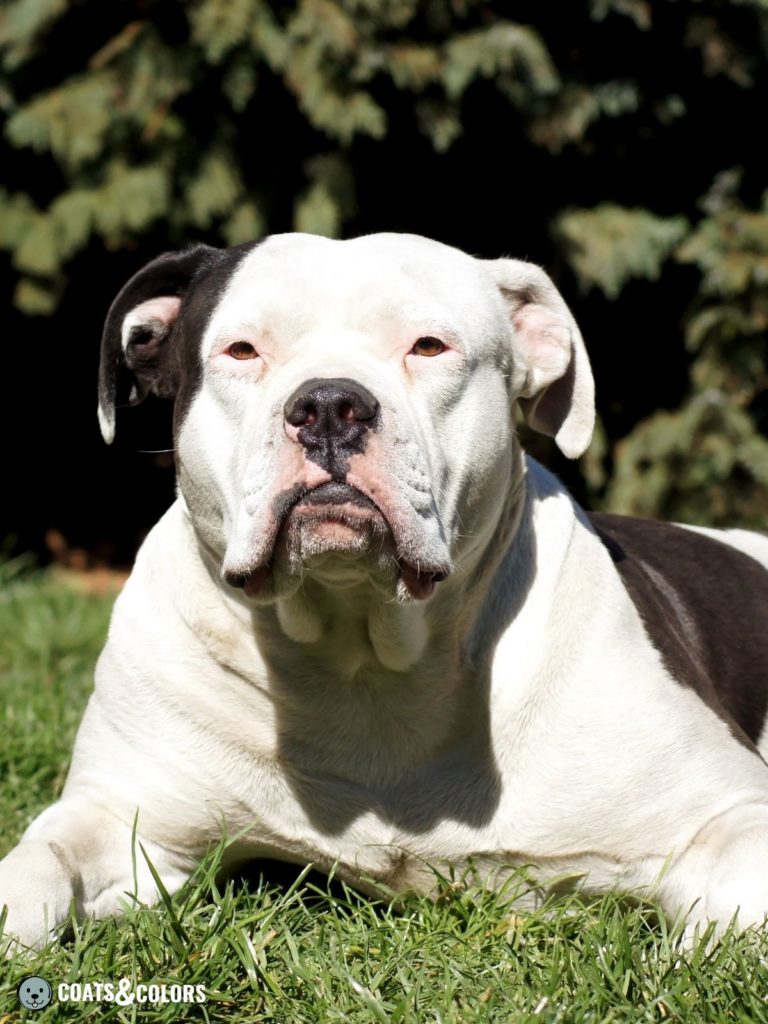

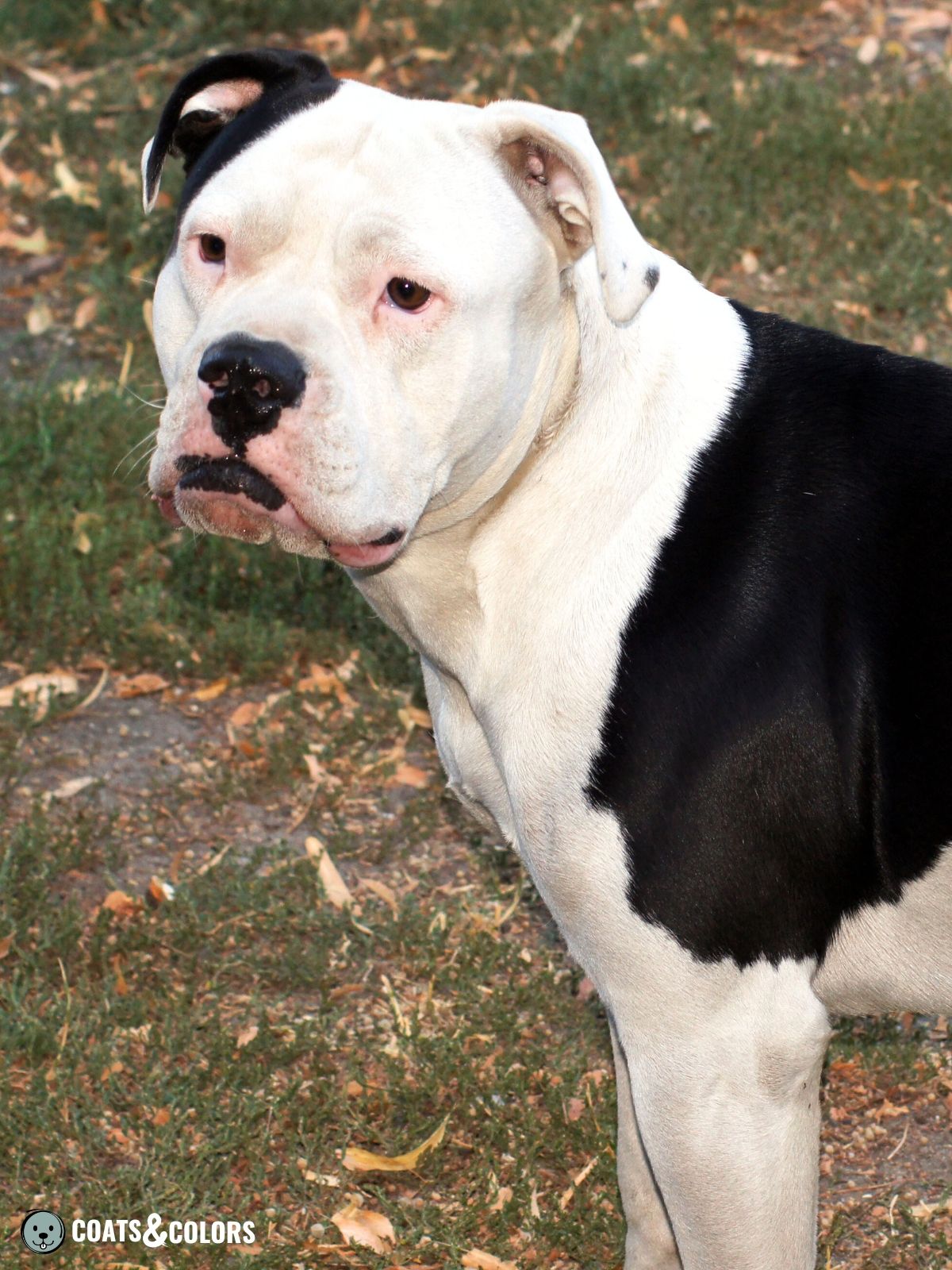
Some American Bulldogs have a dominant black pattern (KB/-). They may carry brindle (KB/kbr) or patterned coat (KB/ky) but are not able to express phaeomelanin in their pattern.
Without the white spotting (from piebald and whitehead), this would produce a solid black American Bulldog. But since about all dogs of this breed show copious amounts of white markings, they are white with black patches.
Some dogs with a very dense brindle pattern (sometimes called black brindle or reverse brindle) may be mistaken for a white & black American Bulldog. That can be the case if they only have very small patches of pigmented coat that don’t give away that they are actually brindle-patterned (kbr/-).
if you have an American Bulldog that looks dark brown but has a black nose, he might be seal.
White & Brown American Bulldog
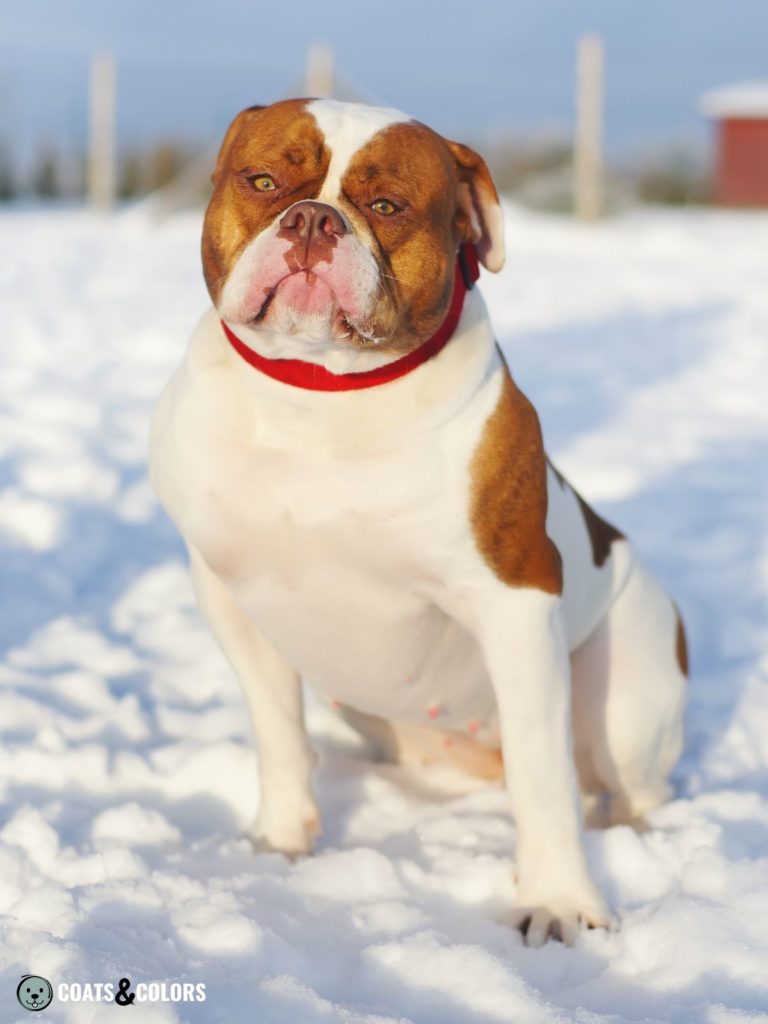
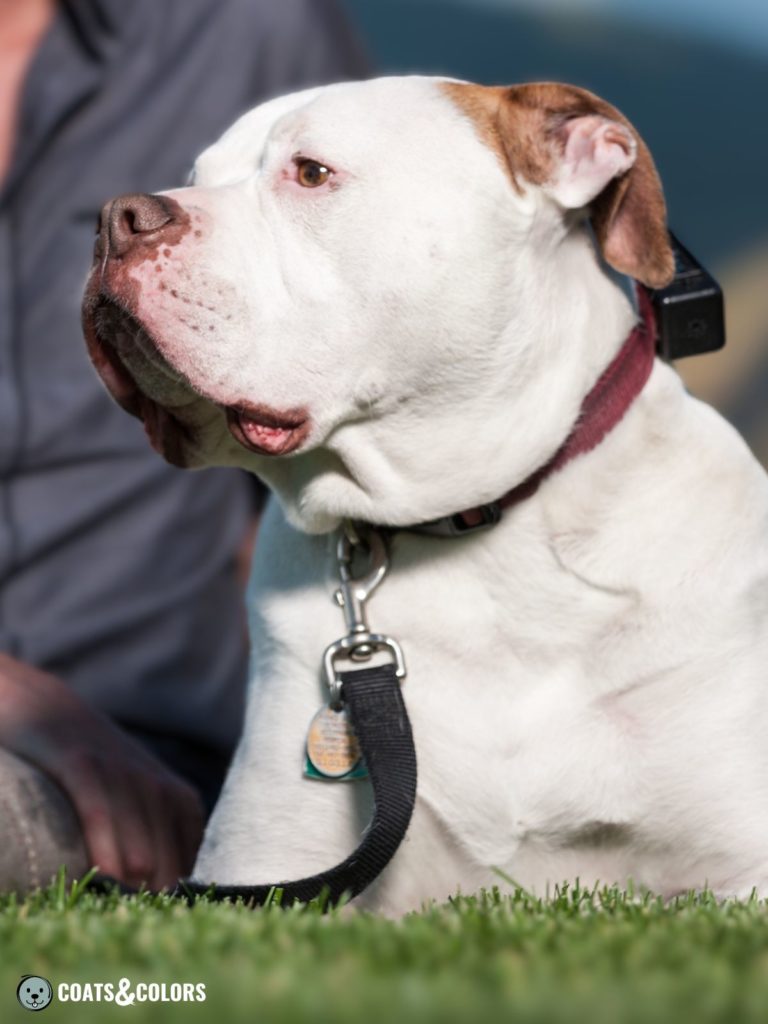

Brown American Bulldogs produce liver-colored instead of black eumelanin.
If an American Bulldog is brown and white, he will have a brown nose as well as brown lips, brown eye rims and brown pigment on his paw pads and nails. Puppy eyes in brown dogs tend to be pale greenish-yellow and darken into hazel or amber colors.
Genetically, brown dogs have two copies of a recessive gene variant (b/b) at the B-Locus. They can’t produce black pigment (only a dog with B/- can) and all of the black in their coat color pattern will be modified to brown.
If they are brindle, all the darker stripes will be brown. Sable dogs may have dark hair tips that will be brown on brown-pigmented dogs. And even a melanistic mask (if visible) will be all brown.
White & Brindle American Bulldog
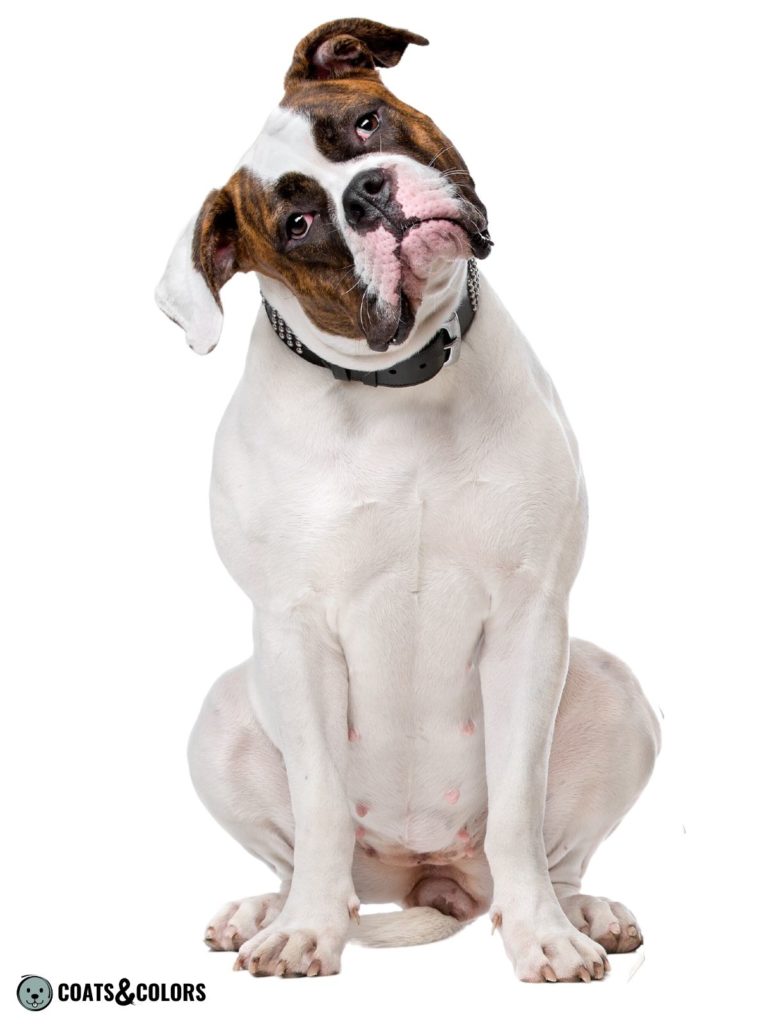
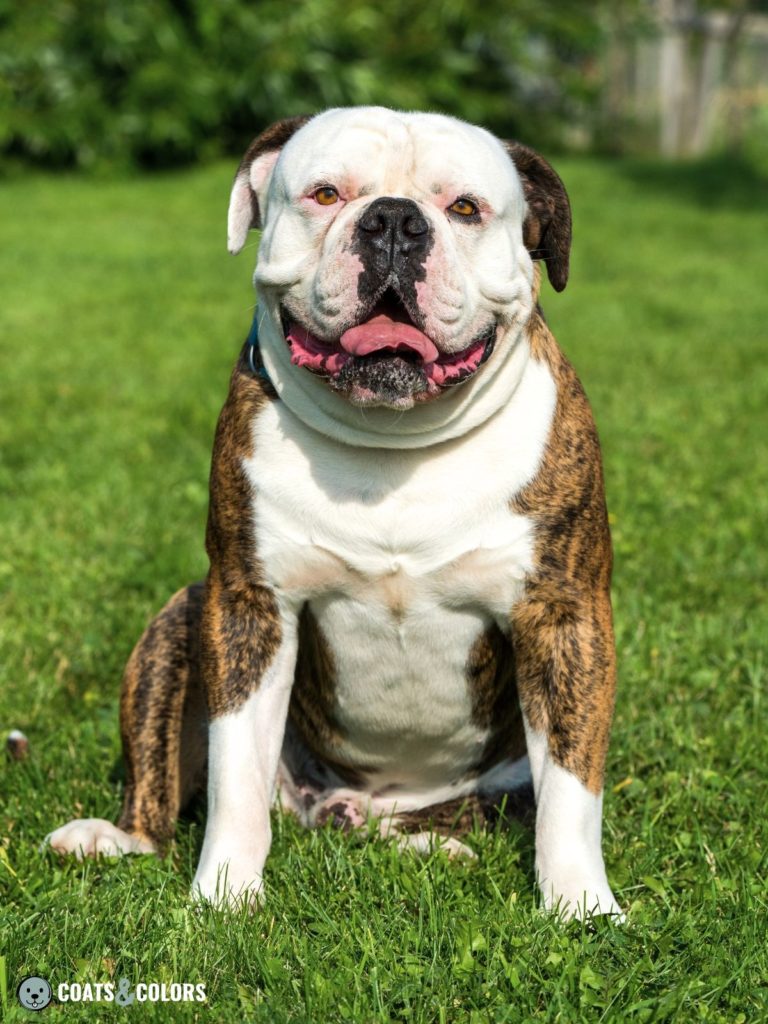
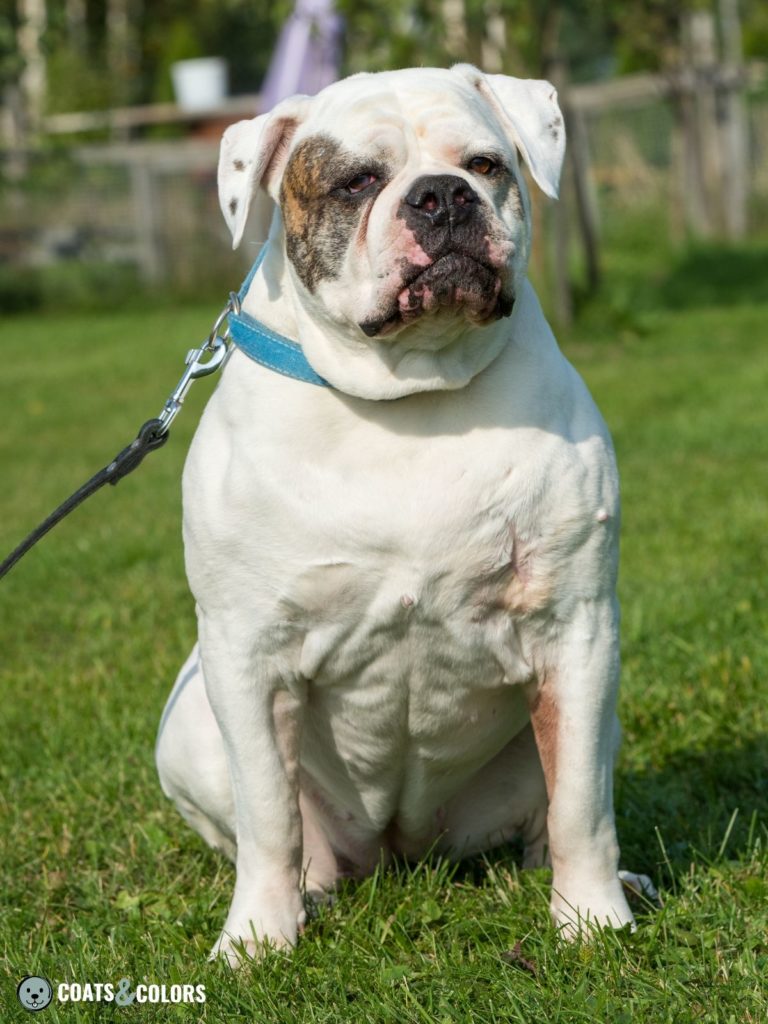
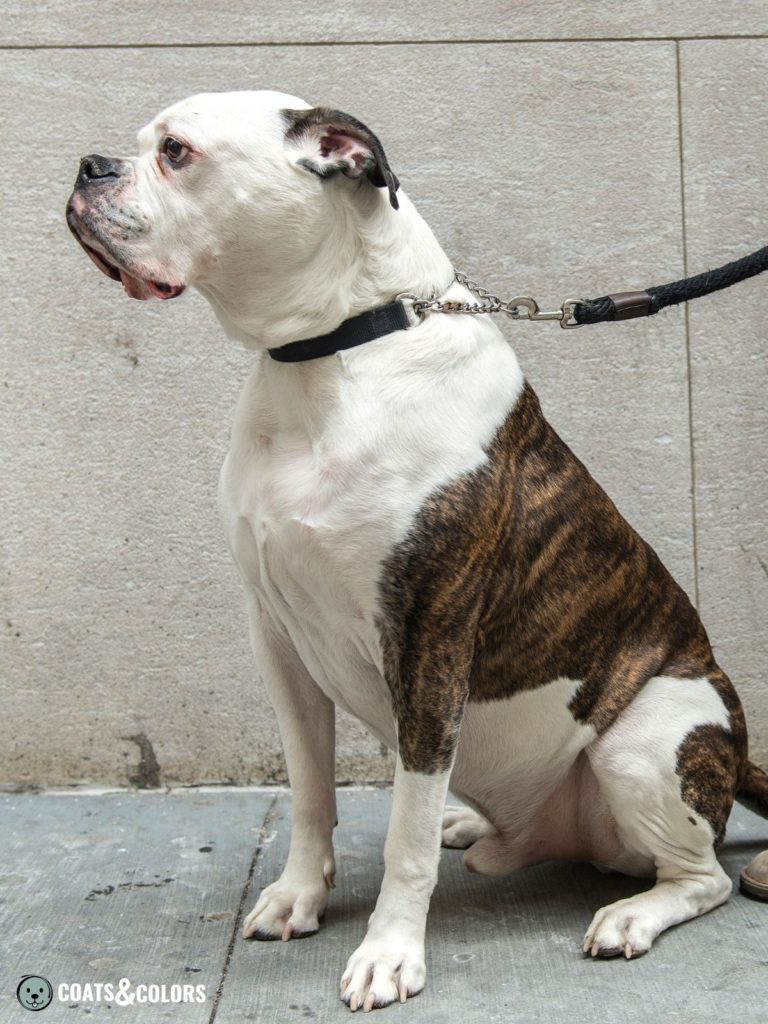
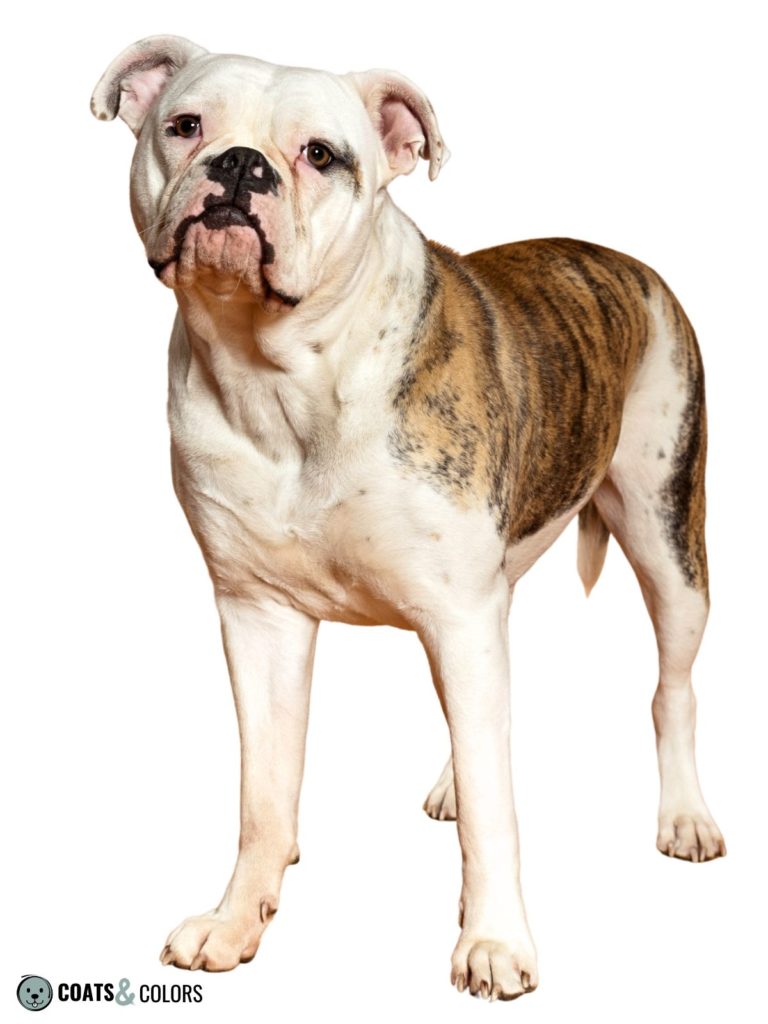
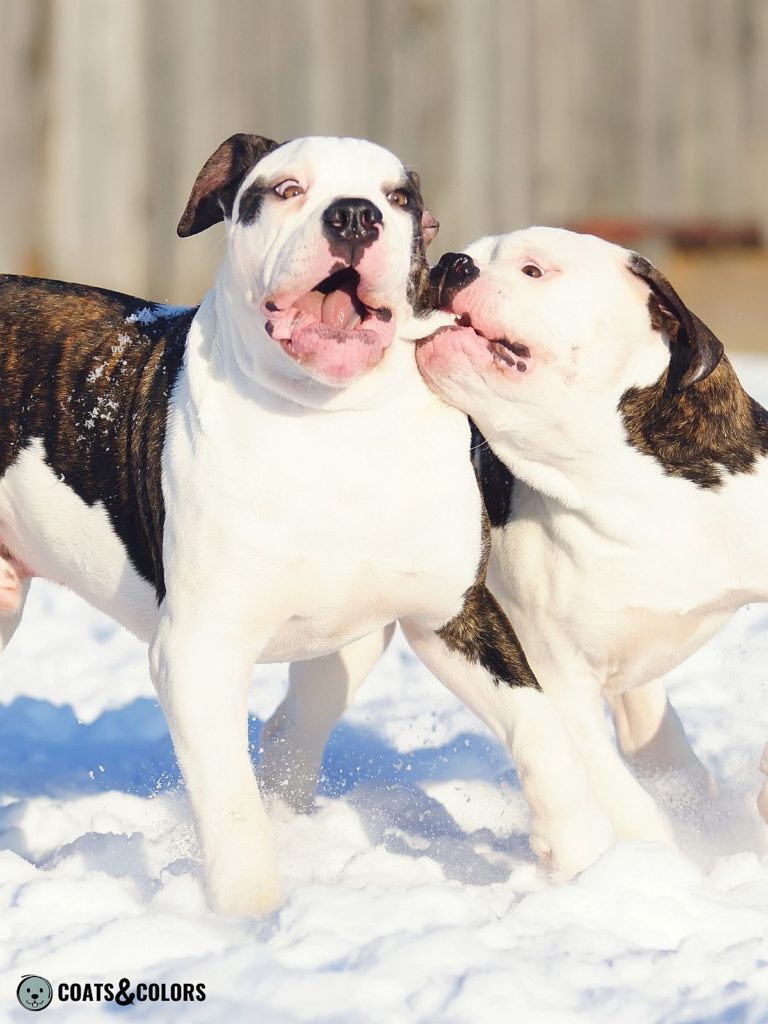
A white and brindle American Bulldog has lots of white coat with brindled patches.
Overall, this is one of the most common coat colors for this breed.
American Bulldog brindle coloring ranges from moderate to very dense striping patterns. If the black stripes are very wide and leave barely any room for red pigment in between, this is called a black brindle or reverse brindle American Bulldog.
In genetic terms, brindle & white American Bulldogs are sable-patterned dogs (Ay/Ay) with a fawn or red base color and eumelanin stripes (kbr/kbr or kbr/ky) on top. Plus white spotting covering up most of the pattern, of course.
White & Red American Bulldog

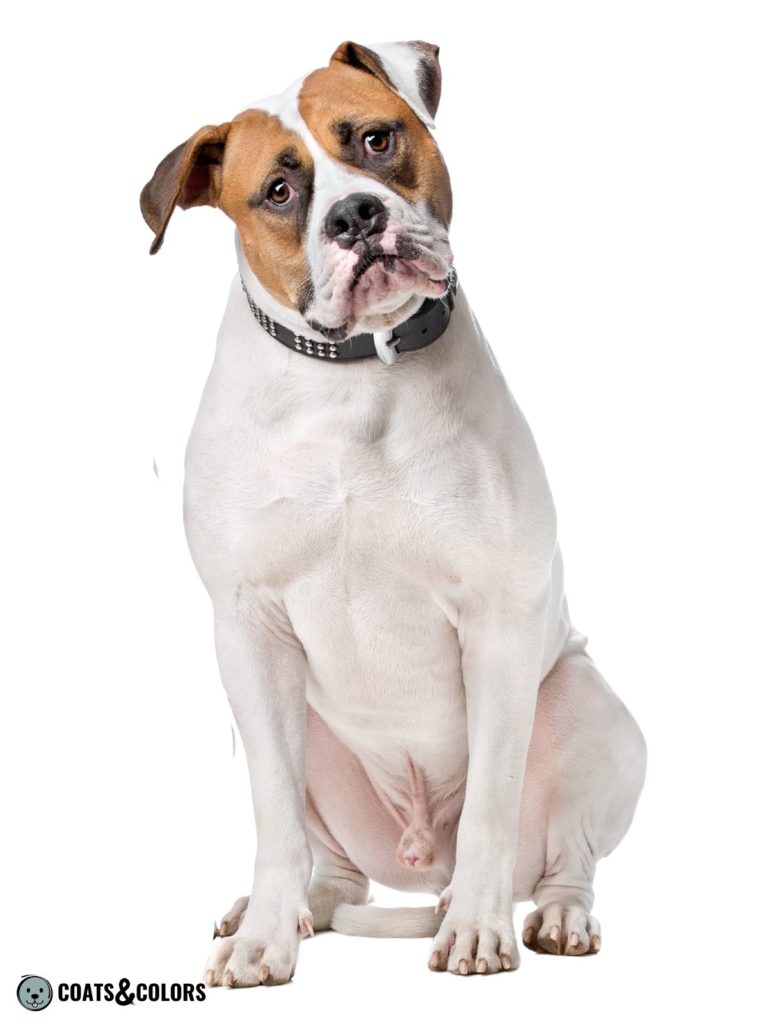
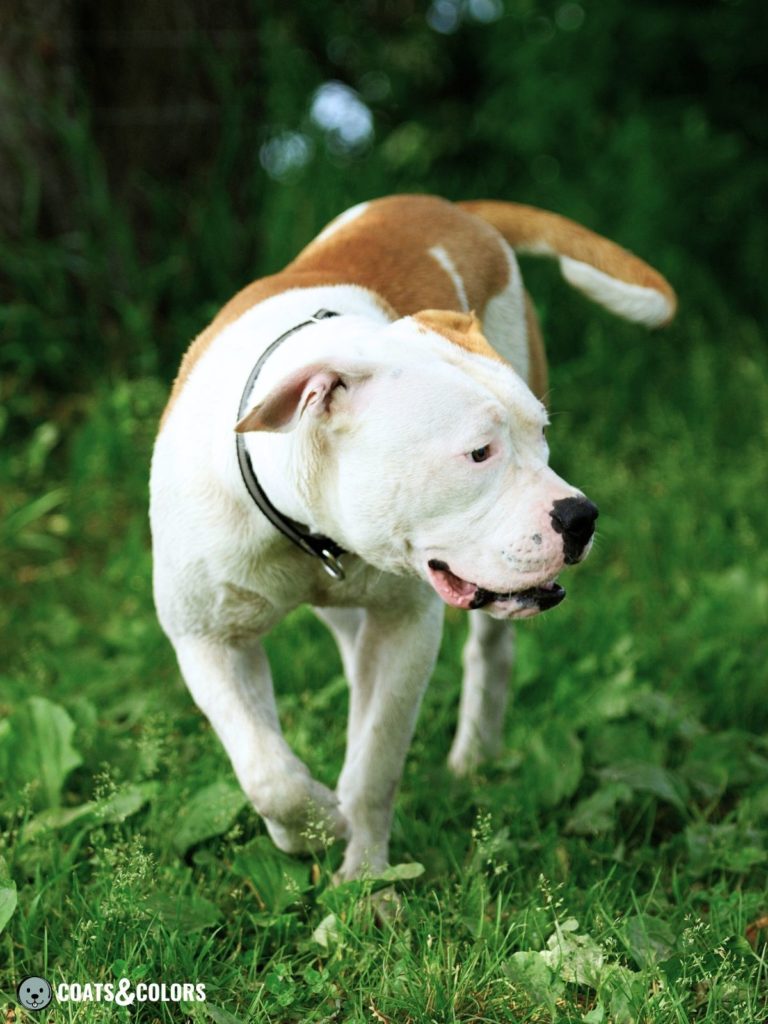
A sable-patterned dog (ky/ky Ay/Ay) with orangey pigment color is called a red American Bulldog. Of course, most American Bulldogs are red and white and have a piebald phenotype with only some red patches.
If enough pigment on the head is not covered by white, dogs may express a black mask (Em/-)
Some red dogs may have some amount of dark hair tips along their head and topline, which would be called shaded sable (ky/ky Ays/-). But many sable-patterned dogs are just born with some dark puppy shading that will fade over time.
A very small number of red American Bulldogs may actually be recessive red (e/e). What sets them apart from clear sable dogs is their inability to produce black pigment in their coat. This may resemble a clear sable pattern in adult dogs and can be impossible to distinguish without genetic testing.
White & Tan American Bulldog
Dogs with a sable pattern and a phaeomelanin intensity that is clearly lighter than what American Bulldog folks consider red are called tan or fawn American Bulldogs. Shaded sable dogs with black hair tips and tan pigment are sometimes called buckskin-colored.
You see, the only difference between a red and a tan American Bulldog is the intensity of their base color. On average, American Bulldog fawn color is more yellowish than a red coat.
Non-Standard American Bulldog Coat Colors
Non-standard colors can happen in any dog breed.
Sometimes these non-standard colors occur by accident due to recessive alleles.
Recessive traits can only be expressed in dogs that have inherited one copy from each of their parents. However, dogs with only one copy will not express the trait but can pass it on for generations.
In purposefully color-bred dogs, a color or pattern deviating from the standard is often achieved by crossbreeding and introducing a new traits on purpose.
Tricolor American Bulldog
A small minority of Bulldogs carry the tan point allele (at) which is recessive to sable coat (Ay/at)[4]. But mating two carriers (Ay/at x Ay/at) can result in puppies that inherited the trait from both their parents (at/at).
And a ky/ky at/at genotype creates a black & tan phenotype. Paired with the always predominantly white coat, this produces a tricolor American Bulldog (black & tan on white).
Black and tan will only be expressed as long as the dog does not also have a dominant black allele (KB). Dogs with dominant black can’t produce red pigment and will not have tan markings.
Dogs may also have a brindle point phenotype if they are genetically brindle (kbr/- at/at).
But the thing is, not every tricolor American Bulldog may look like one. The pattern is only visible if some pigmented patches fall into areas that clearly show black and tan markings. Otherwise, the dog might just look black & white.
Black Mask American Bulldog
All breed standards regard a full black mask as a fault. Surprisingly, the majority of American Bulldogs have this trait in their genotype (Em/Em or Em/E)[4].
They just can’t express it fully because of their almost always mostly white heads.
Merle American Bulldog
Some color breeders produce blue merle American Bulldogs. But although merle American Bulldogs may look striking, the color does not meet the breed standard.
Blue American Bulldog
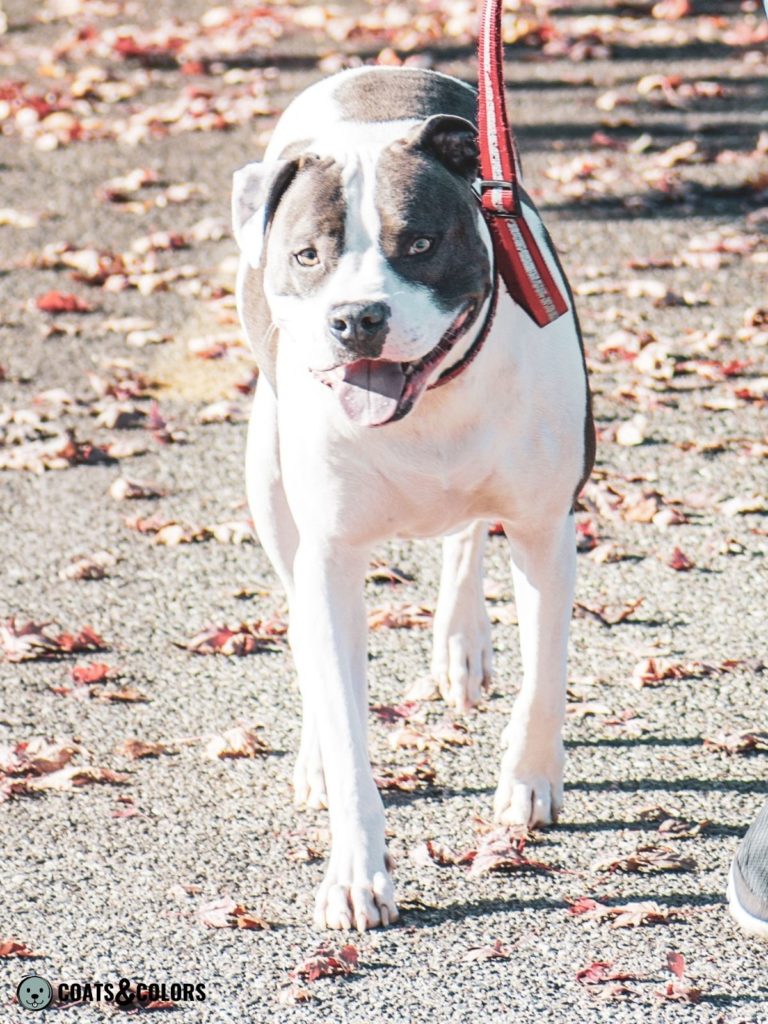
Blue pigment happens if you combine black pigment (B/-) with two copies of color dilution at the D-Locus (d/d). This will turn all black pigment to a charcoal gray or blue-gray.
But not all blue and white American Bulldogs will have solid blue patches. Since most dogs of this breed are brindle- or sable-patterned, the blue color only affects the eumelanin in a given pattern.
A blue or gray American Bulldog may be blue sable or blue brindle (or blue tricolor if a breeder goes after non-standard markings anyway). Color dilution also affects the skin and nose pigment. So blue dogs have a slate-gray nose.
Gray American Bulldogs also tend to have blue eyes as puppies that will darken into a paler yellowish or amber color than what you would expect in a black dog.
Lilac American Bulldog

Finally, lilac is a combination of brown pigment (b/b) and eumelanin dilution (d/d). It is a popular color among bully breed owners but not a standard color in American Bulldogs.
A lilac- or beige-looking American Bulldog will have a taupe-colored nose and pale eyes along with lilac eye rims, lips and skin pigment. And all of the eumelanin in his pattern will be turned to lilac.
Just as with blue dogs, a lilac American Bulldog may come with solid patches. But dogs with patterned coats might be lilac fawn, lilac brindle or lilac tri, whatever their original pattern.
American Bulldog Coat Colors Overview
The breed standard describes all the different traits an American Bulldog should have.
This includes his conformation and temperament but also the coat texture and color of an ideal representative of this breed. Currently, the AKC does not provide a standard for the American Bulldog. But the breed has been accepted in the AKC Foundation Stock Service.
Some breed clubs have published a breed standard. These are similar in their general outline regarding American Bulldog colors[2,3]:
| AKC | HABCA | ABA | |
|---|---|---|---|
| White | ✅ | ✅ | ✅ |
| White & Black | ✅ | ✅ | ✅ |
| White & Brown | ✅ | ✅ | ✅ |
| White & Brindle | ✅ | ✅ | ✅ |
| White & Red | ✅ | ✅ | ✅ |
| White & Tan/Fawn | ✅ | ✅ | ✅ |
American Bulldog Coat Color Genetics
A dog’s coat gets its colors from two pigment types called eumelanin and phaeomelanin. Different proportions of colors in a particular dog’s coat create different patterns.
But American Bulldogs, like most dog breeds, can only produce some of all the possible colors. These are the genes and alleles involved in standard American Bulldog coat colors and patterns:
| E-LOCUS | Em = melanistic mask E = normal pattern e = recessive red (rare!)[4] |
| K-LOCUS | KB = dominant black kbr = brindle ky = normal pattern |
| A-LOCUS | Ay = sable Ays = shaded sable at = tan points (rare!)[4] |
| B-LOCUS | B = black b = brown, liver |
| D-LOCUS | D = normal pigment d = color dilution (non-standrad color) |
| S-LOCUS | S = no spotting sP = piebald spotting |
| M-LOCUS | m = non-merle |
Eumelanin Colors
American Bulldogs mostly come with black pigment (B/-), some produce brown pigment (b/b). Eumelanin diluted to blue or lilac (d/d) happens but does not conform to the breed standard.
Dogs with black pigment will have a black nose while dogs with brown pigment have a brown nose.

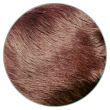
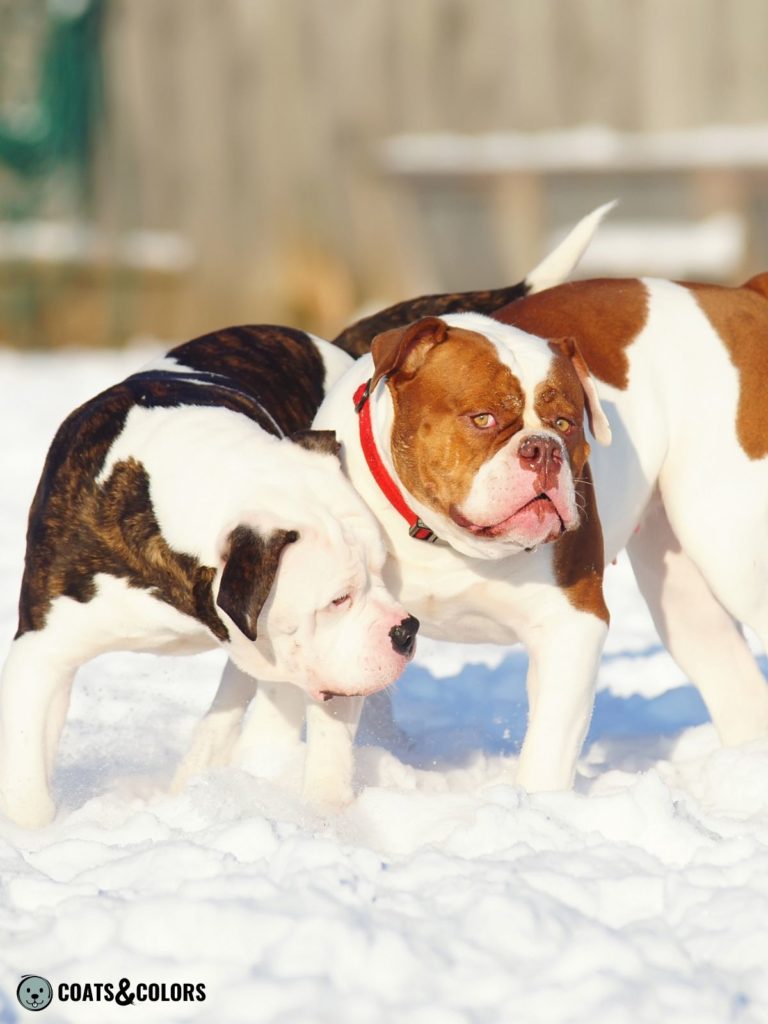
Phaeomelanin Intensity
A vivid orangey-red phaeomelanin intensity is called as red while lighter coats are called tan or fawn.

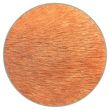
White Spotting
White spotting is the trademark of American Bulldog coat colors.
Dogs can be solid white or pied. Overall, patterns with a large amount of white are preferred by many breeders. The traits that cause white spotting in American Bulldogs are piebald and whitehead.
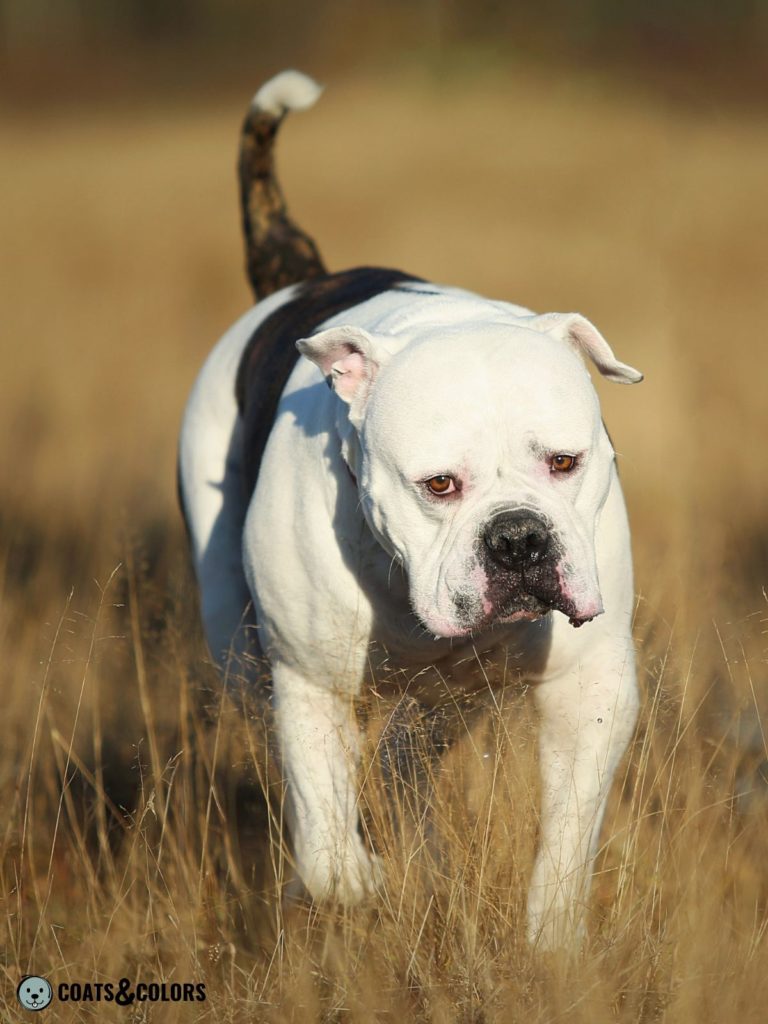
But not all dogs are high white. Many have a pinto pattern with colored patches. And a small number of American Bulldogs are mostly pigmented with just a flashy white trim on the legs and chest.
There are even some downsides to having a high white phenotype.
Whatever disturbs the normal migration and development of pigment cells, can also affect the ones that were destined to end up in the skin, eyes or ears.
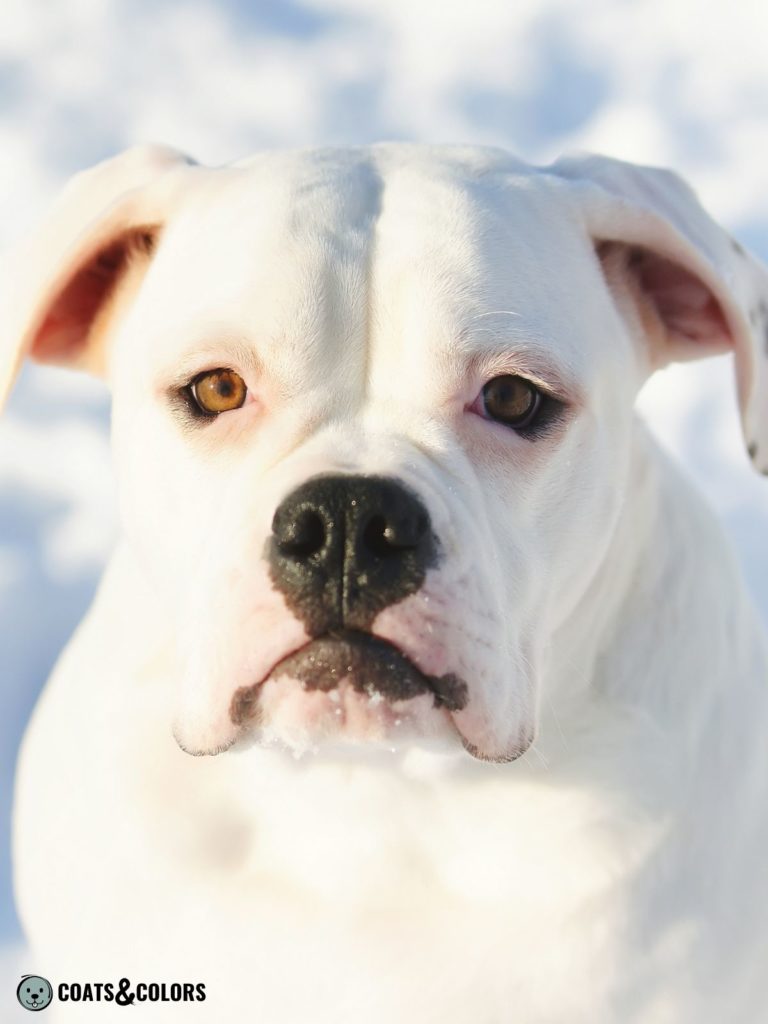

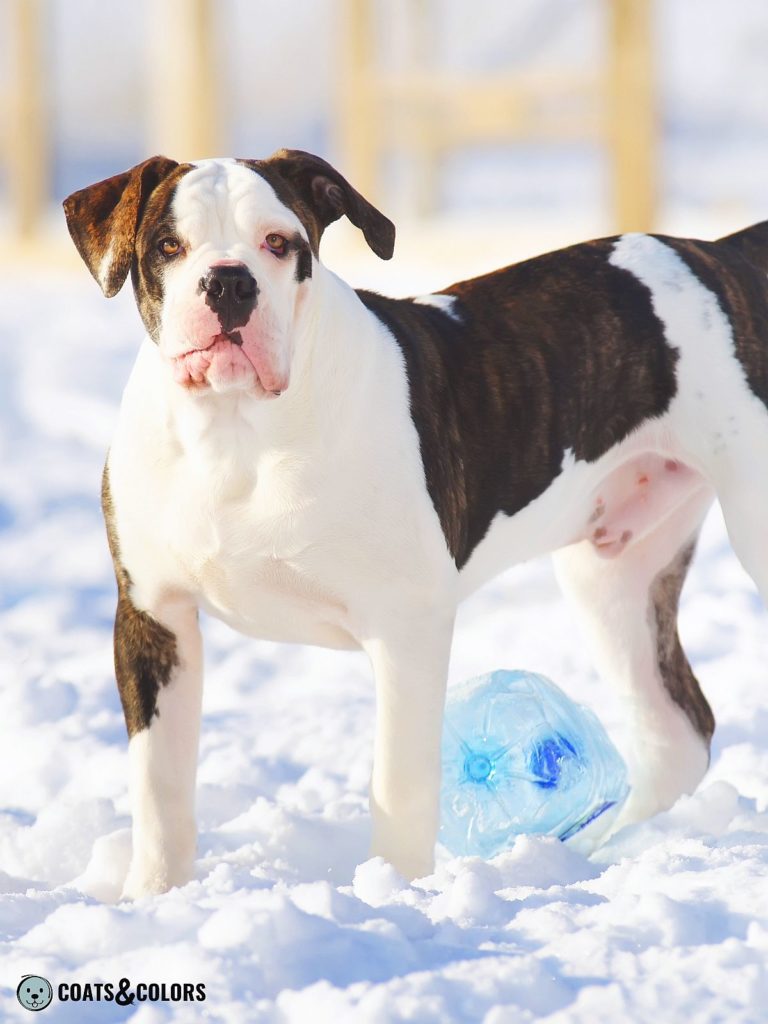
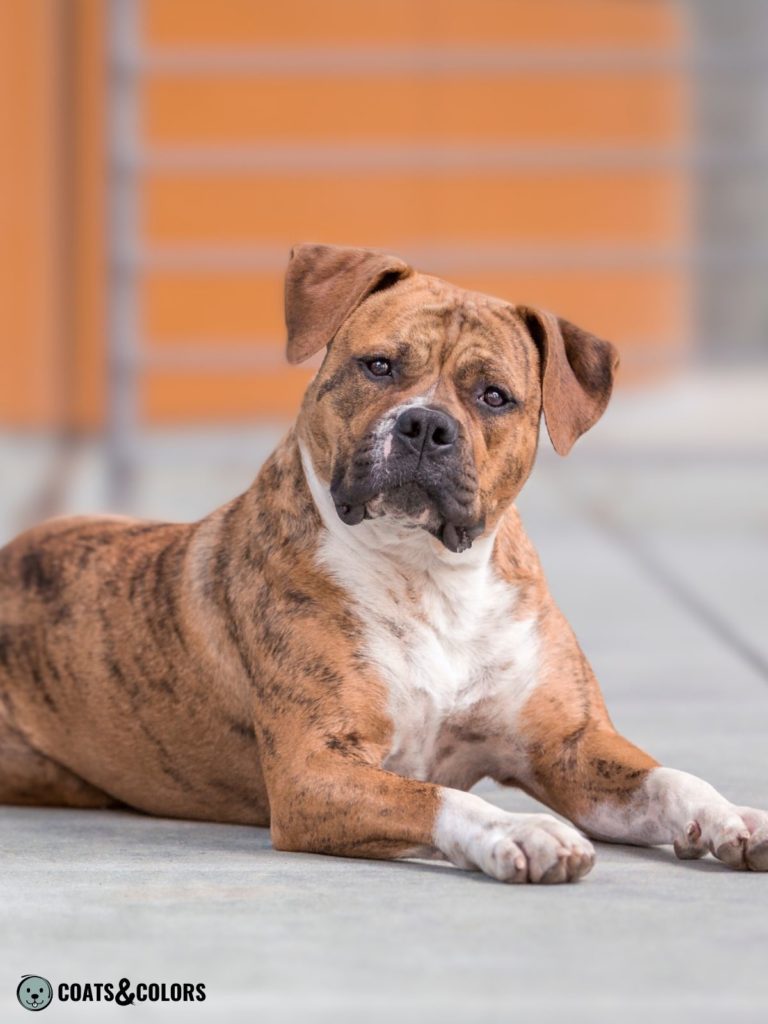
This increases the likelihood for American Bulldogs with lots of white on their head to suffer from deafness, having blue eyes as well as a lack of pigmentation on the eye rims or nose.
Breeders can select for fully pigmented noses, eyes and eye rims. They can BAER test their puppies for congenital deafness (and they should, as unilateral hearing loss can be hard to detect otherwise).
But this phenotype will always pose an element of risk because white spotting is not fully predictable.

Color Patterns
The accepted patterns in a dog breed describe the distribution of colors in a dog’s coat. Dogs can be solid-colored or have a pattern with more than one color.
Breed standards almost always use breed-specific and purely descriptive terms. It’s sometimes on us to translate breed standard terminology into more universal genetic terms.
And that can be quite tricky… Sometimes the same term is used for colors that are caused by different genes. And in other cases genetically similar phenotypes have many different names.
| Color Term | Genotype |
|---|---|
| White | sP/sP (+ whitehead) |
| White & Black | Em/- KB/- B/- E/- KB/- B/- + white spotting (+ whitehead) |
| White & Brown | Em/- KB/- b/b E/- KB/- b/b + white spotting (+ whitehead) |
| White & Brindle | Em/- kbr/- Ay/- E/- kbr/- Ay/- + white spotting (+ whitehead) |
| White & Red | Em/- ky/ky Ay/- E/- ky/ky Ay/- + white spotting (+ whitehead) + red phaeomelanin |
| White & Tan | Em/- ky/ky Ay/- E/- ky/ky Ay/- + white spotting (+ whitehead) + fawn phaeomelanin |
American Bulldog Nose and Eye Colors
American Bulldogs come with black or brown pigment. Their preferred eye color is brown although brown dogs tend to display more yellowish eye colors.
The large amount of white in their facial pattern predisposes American Bulldogs for ending up with one or even two blue eyes. Breeders don’t like that, but it is a reality when breeding whitehead puppies.
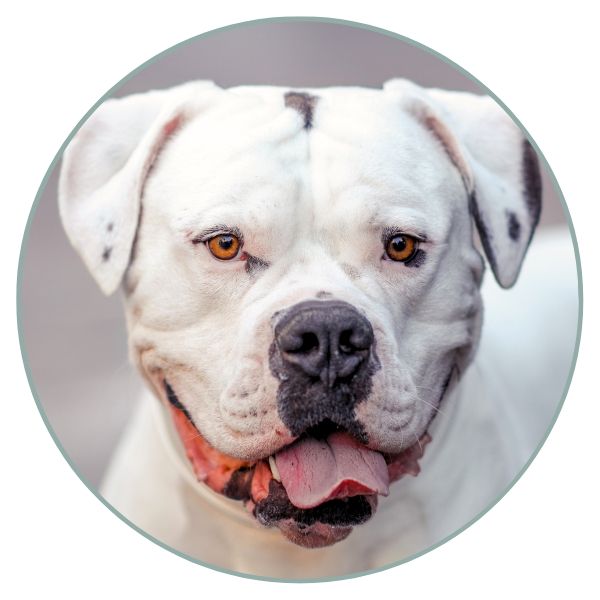
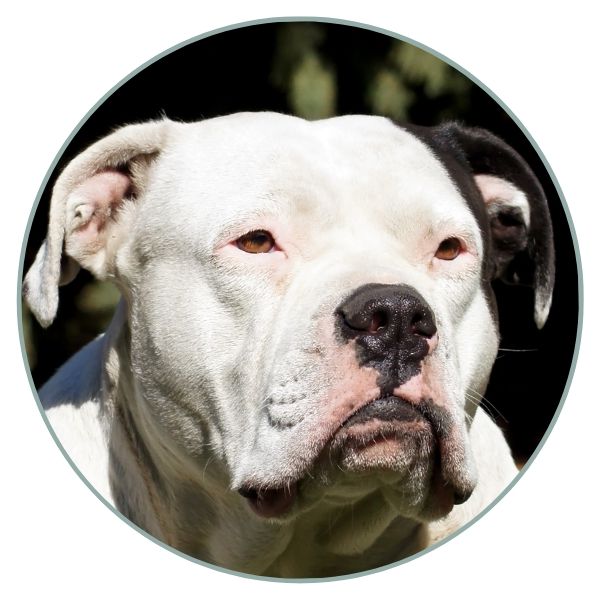
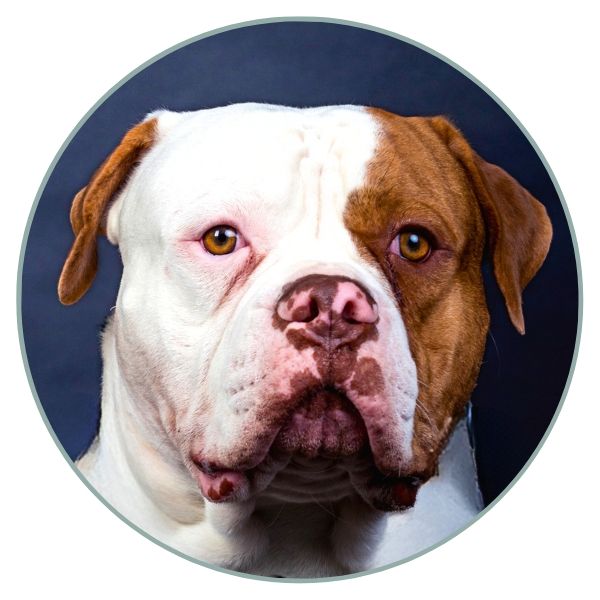
American Bulldog Coat Type
American Bulldogs are short-haired. Their close guard hairs are soft or stiff to the touch.
Other Coat Types in American Bulldogs
Some American Bulldogs seem to carry the gene variant for long coat[4]. If two carriers (L/l) are paired they may produce long-haired offspring (l/l) with visible feathering on the ears and legs.
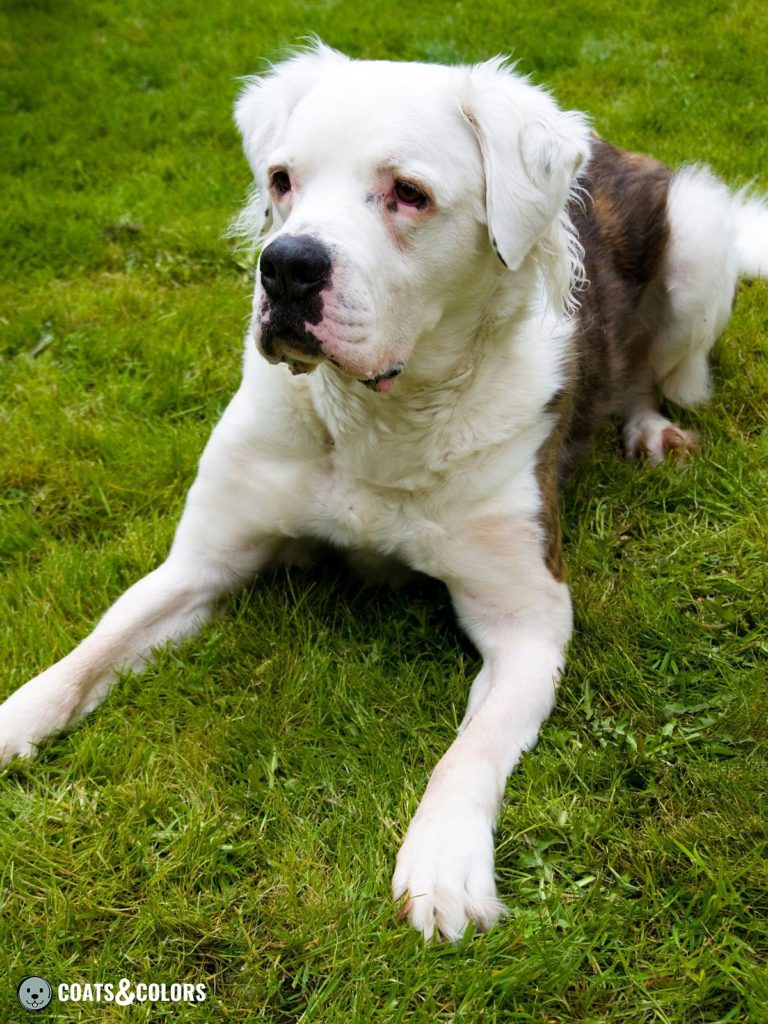
Learn More
Links
[1] American Kennel Club (AKC): American Bulldog
[2] Heritage American Bulldog Club of America: Standard for the American Bulldog
[3] American Bulldog Association: American Bulldog Breed Standard and Rules
[4] Dreger et al. (2019). True Colors: Commercially-acquired morphological genotypes reveal hidden allele variation among dog breeds, informing both trait ancestry and breed potential. PLoS ONE 14(10): e0223995. https://doi.org/10.1371/journal.pone.0223995

Hi! I’m Steffi. I am a biologist and a big time dog nerd. You are curious about coat color genetics? You’ve come to the right place! Read more.



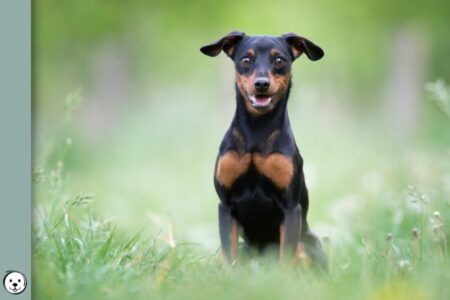
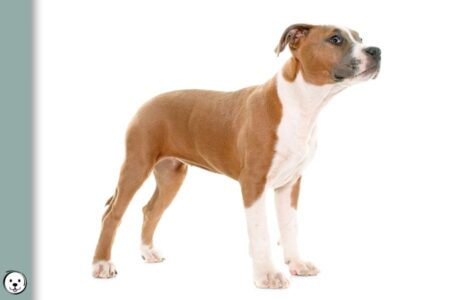

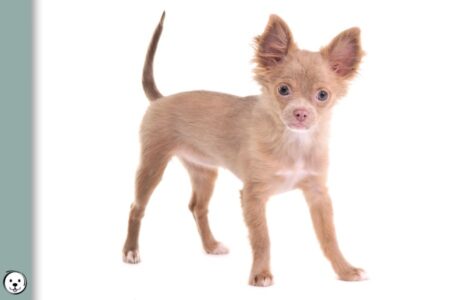

2 thoughts on “American Bulldog Coat Colors”
Comments are closed.